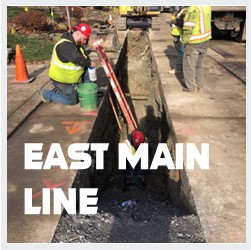Information Flow | LDWA System Project Update
Updated: 01/2024
The purpose of this page is to provide information about current Leeds Domestic Waterusers (LDWA) projects, and inform the community about potential impacts during construction. Although the LDWA understands that construction creates an inconvenience, it is committed to keeping the community informed.
Construction Project Updates
As a culinary water provider, we continuously upgrade, maintain, and repair our system so it can continue to serve our customers. The purpose of this page is to provide information about current LDWA projects, explain their need and benefits and inform the community about potential impacts during construction.
Although the LDWA understands that construction creates an inconvenience, it is committed to keeping the community informed of current projects, while working to minimize construction impacts as much as possible.
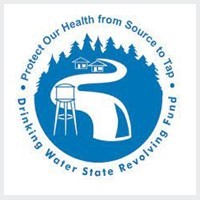 Utah Division of Drinking Water, State Revolving Fund (SRF) Package
Utah Division of Drinking Water, State Revolving Fund (SRF) Package
On August 31, 2022, the Division of Drinking Water (DDW) Board met and authorized a loan of $7,519,500, with $3,499,500 principal forgiveness to LDWA for drilling a new well, installing a chlorinator, installing an altitude control valve and vault, replacing 4,500 feet of water main and transmission line replacement. The loan terms offered to the LDWA are forty (40) years, at an annual Interest Rate of 0%.
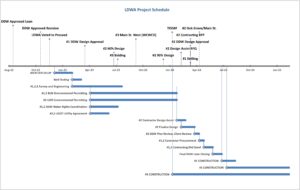
Current Project Schedule
Updated Schedule 01-31-2024
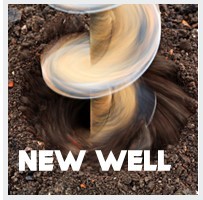 PROJECT 1 OVERVIEW :: New Well
PROJECT 1 OVERVIEW :: New Well
BACKGROUND :: LDWA currently gets its water from Oak Grove Spring and Highland Well. The water from the spring is shared with the Leeds Water Company (LWC) irrigation company. LDWA’s portion amounts averages about 120 gallons per minute. The well can produce approximately 335 gallons per minute. The total average source capacity adds up to 455 gallons per minute.
Over the years the several LDWA Boards have wisely commissioned a number of Water Capacity Studies to be completed, by multiple consulting engineers, on the system. In each of the last four studies (2007, 2015, 2017 & 2021), it was identified that the LDWA is deficient in source when using the State of Utah Drinking Water guidelines. It has been recommended that a new well location and well in the amount of 700 gallons per minute be secured, drilled, and developed.
In 2010 a Loan was secured by the LDWA, and a project scoped out within it was the drilling of a new well. Unfortunately, after 2 failed attempts to locate a suitable location, this project was terminated.
UPDATE :: The current well project has been divided into 2 parts: A) the well drilling/construction and B) the well house, backup generatorz, new well equipment, chlorinator and altitude valve. Also, rather than drilling a pilot hole, it was suggested by our consulting professionals, that increasing the capacity of the existing well so as to determine the strength of the aquifer would be the best approach to locating the new well. This was done with great success in creasing our current well capacity to 600 gpm the allowing the new well to be located nearby, due to the unique capacity of the aquifer beneath the existing well.
Project #1A – Well Drilling
- LDWA has submitted an environmental application to BLM and received verbal approval for a Categorical Exclusion, which is the fastest and simplest NEPA category. BLM will be documenting this categorical exclusion in house. Drilling cannot occur until the categorical exclusion is approved, but the verbal approval gives us momentum forward.
- LDWA has approved the well design and engineering completed by JDE, and we are poised to advertise for driller contractors.
- LDWA has successfully submitted change applications to use all underground water rights at both well sources. This includes a separate change application to segregate from unusable sources located at Sand Hollow reservoir.
- The next steps for LDWA are:
- Obtain the final BLM Categorical Exclusion permit.
- Review the bid and contract packages and advertise and select a well driller.
- Drill and test pump the new well.
Project #1B – Well Equipping, Expanded Well House, Chlorinator, Altitude Valve
- JDE design is at 90% completion and is prepared to send out a request for a qualified contractor (RFQ). The RFQ is scheduled to be reviewed and approved by the February 2024 shareholder meeting. The design assist contract includes the well house necessary equipment including chlorination system and backup generator, Oak Grove Springtransmission line, and East Main Street pipeline replacement.
- BLM permitting is at the same stage as the well drilling. The USFS has accepted the application but is considering the level of environmental process they will accept.
- In spring and summer of 2024, work will be done with the selected contractor to finalize the design phase and negotiate for construction. Contractor responsibilities for the design assist contract includes sourcing materials for budget management, pot holing, and sequencing the project for the well building, hydrants, and meter services connections. Large budget items will also be quantified and reviewed; e.g. rock cut excavation.
- Next Steps:
- Close on the WCWCD portion of the loan.
- Advertise for qualified contractors and begin the design assist effort of reviewing plans and materials.
- Obtain USFS application approval and proceed with environmental clearances.
- Negotiate construction contract and begin construction.
- Completed:
- Installed a larger pump in the existing well and successfully tested the aquifer for an additional nearby well. This increased source capacity goes a long way to ensuring LDWA meets DDW criteria and existing demands.
- Used the existing piping with minimal connections to improve the overflow from the Highlands tank so that it is correctly routed back to Leeds Creek. This was a very efficient use of existing resources.
- A fire break was cleared for the existing and soon to be replaced well house at no cost to LDWA.
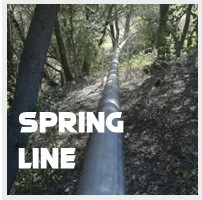 PROJECT 2 OVERVIEW :: Spring Transmission Line Replacement
PROJECT 2 OVERVIEW :: Spring Transmission Line Replacement
BACKGROUND :: Our Spring capture basin and 4” steel water line was constructed in 1954 at great cost and sacrifice by some amazing pioneers in this area. We owe them a great deal of thanks and admiration for their determination, grit and forward thinking. They sacrificed time, labor and money not just for themselves but for us, the future beneficiaries.
As with all things, age takes its toll and this line has reached its projected useful life. In addition, we were able to increase theOak Grove Spring flow last year by removing some of the trees surrounding Oak Grove Spring. It is projected that removing more of this water intensive vegetation and some modifications below the spring can further increase flow. LDWA water rights from the Spring is dependent on the total flow of Leeds Creek and the Spring. As agricultural land is developed it is anticipated those agricultural water rights will be transferred to allow LDWA to serve those retired lands with culinary water.
Consulting engineers have analyzed the overall conditions of the Oak Grove watertransmission pipeline as well. Their findings indicate that the 69-year old line is nearing the end of its expected service life, based on the extremely corrosive soils in and around Leeds and the typical service life of steel pipe in surrounding areas. The recent repairs to the lower portion of the Spring pipeline indicate that failure has started occurring in varying degree. Steel pipe becomes brittle with corrosion and is further vulnerable to landslides and earthquakes. As the primary year-round water source, the engineer determined that the Oak Grove and Spring transmission line should be replaced as soon as is feasible.
By replacing the current 4”, 68-year-old water line with a new larger 8” line we assure continued and possibly increased Spring water flow both now and into the future.
UPDATE :: The design of the Spring Transmission Line is 90% complete. An 8” HDPE pipe (as opposed to the existing 4” iron pipe) is proposed and will convey water from the spring collection to the Oak Grove tank. Design improvements include a large reduction of air valves, which have been difficult to maintain in the past. Also, metal boxes that are currently used to reduce the pressure of the spring line, will be replaced with buried concrete structures that are compliant with State Code. These boxes will be secured and elevated and will provide for additional means to isolate portions of the Spring Line for maintenance. The new transmission line will be located adjacent to the Oak Grove road, to improve visual inspections and maintenance. Exposed portions of the pipe will be properly buried and protected.
- This project includes well house and equipping, oak grove line, and east main street main. So please also refer to Project #1B – Well Equipping, Expanded Well House, Chlorinator, Altitude Valve listed above.
- Corrected the USFS permit for the spring to ensure that it is recognized lease on USFS land.
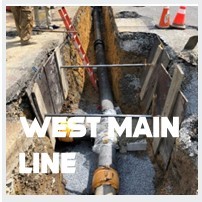 PROJECT 3 OVERVIEW :: Distribution Line Replacement [West]
PROJECT 3 OVERVIEW :: Distribution Line Replacement [West]
BACKGROUND :: The west side Main Street main water pipeline was installed in 1976 making it 46 years old reaching its useful life for a PVC main water line. Besides being undersized for fire flow by today’s standards, the strength, wall thickness and durability of this pipe is substandard. (Class-C as opposed to superior current C-900 PVC specifications)
This line is the one connected directly to our Fire Hydrant System through the center of Town. The intent is to replace this 6” line with a 10” line to accommodate future water needs at the south end of Leeds and to meet current Fire Hydrant flow requirements for industrial, commercial, municipal and larger structures along Main Street.
Since the Washington County Water Conservancy District, WCWCD, is moving ahead to replace their failed large main water line which passes through Leeds, we have been able to work cooperatively with them to replace our line at the same time thus saving cost on shared engineering, pipe pricing (volume purchasing), trenching, asphalt replacement, and safety signage and routing. This cost savings is significant.
Having the West Side of Main Street torn up once instead of twice will not only lessen cost but reduce the time of inconvenience to the citizens of Leeds.
UPDATE :: Construction is currently ongoing by Landmark Excavation. The LDWA portion of the work is scheduled to begin in February 2024.
- There is a joint effort between JDE and LDWA for inspection, communication, and quality control during construction.
- A portion of the funding has been dispersed to LDWA by the DDW for the design of the project. It is anticipated that the WCWCD portion of the funding will close with the DDW in February 2024.
- LDWA has provided services to Landmark Excavation, ranging from the certified water operator locating lines to providing sequencing shutdowns and/or connection points.
- WCWCD has been very supportive of LDWA, resulting in significant savings for the shareholders through their partnership.
- Successfully joined with WCWCD to complete the main street west pipeline. LDWA saw a very significant savings to the overall project costs by teaming with the WCWCD.
- LDWA established a baseline right of way map for the current system. County records were compiled for right of way compliance.
WCWCD and Landmark Excavation: 01-22-2024 Leeds Waterline Schedule Update
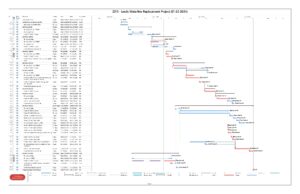
PROJECT 4 OVERVIEW :: Distribution Line Replacement [East]
BACKGROUND :: Portions of the Main Street east side water pipe line suffers from some of the same conditions as that of the west side line, however it is somewhat newer and the upper end above Vista Avenue has previously been replaced with 8” pipe. The plan on this side is to replace the older Class C, 6” water line below Vista Avenue with new 8’ line.
UPDATE :: Refer to Project #1B – Well Equipping, Expanded Well House, Chlorinator, Altitude Valve listed above.
